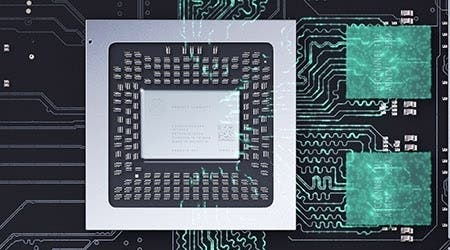The big Xbox Series S interview: why Microsoft made an entry-level next-gen console
"For me, it was an easy decision - let's go do this."
We knew it was in development, we even got to see it during our visit to the Microsoft campus back in March - but today, Xbox Series S launches and it's a fascinating product. Targeting an aggressive $299 (£249 in the UK) price-point, the junior next-generation Xbox allows users access to a much cheaper console that still plays the same games as the premium/performance Series X that's $200/£200 more expensive. The story behind the machine is remarkable and illuminates the challenges the platform holders will have in reducing costs over time, as well as suggesting a difficult time ahead in delivering a generational leap in console performance beyond Series X and PS5. I spoke to Xbox system architect Andrew Goossen about Series S in person back in March and in a follow-up call several months later after the system was revealed.
The bulk of this Xbox Series S discussion actually began after wrapping up an interview mostly centred on Series X. We'd seen Series S in the flesh the day before, but it wasn't clear how much Microsoft wanted to talk about its entry-level machine - we hadn't even got to see it in action. "If you don't mind, there's another thing that I did want to mention as well," began Andrew Goossen, and that's the beginning of what turned out to be a truly remarkable discussion, giving a hitherto untold story about the challenges in delivering new console hardware.
"Series S has been very impactful for us. As we design our new consoles for the new generation, we're very much looking forward through the generation to be thinking ahead - like, how does this work? - and that's why we got to two consoles at the same time," Goossen continued. "We are facing a big change in how consoles are designed. I believe when we first started building the original Xbox 360 - the smallest one without the HDD - that cost us about $460. By the end of the generation it cost us around $120 - and that cost reduction path was driven principally by silicon cost reduction."
To put that into perspective, Xbox 360 launched with individual CPU and GPUs, both fabricated at 90nm. By the generation's end, those two components had been combined into a single chip, delivering a significant cost reduction in its own right, and they were also delivered using a much smaller process (possibly as low as 32nm on the final model). Between launch and the end of the 360's lifecycle, the machine had actually transitioned through several fabrication nodes. Its successor - Xbox One - saw its processor revised just once, down from 28nm to 16nm FinFET. Cost reduction opportunities were thin on the ground for this generation and will be even more constricted going forward.
"Moore's Law is certainly not dead! Moore's Law is continuing and we have a good path to 5nm and 3nm, and those are going to bring improved performance and good power," enthuses Goossen. "What they're not bringing any more is a good cost reduction cost per transistor - and so this has foundational impacts to console development, because now we'll get cost reductions, but they're slowing down and it won't be nearly the magnitudes that we've seen before."
The fact is that future nodes like 5nm and 3nm do deliver advantages then - and PC processors and GPUs along with smartphones can still benefit from those. But typically, consoles stick to the same performance profile across the generation. Goossen is essentially suggesting that leveraging these nodes for cheaper consoles may not be an option, which poses a difficult problem for the Xbox team going into the future with the intention of delivering even more powerful hardware. Processor performance is tied closely to transistor count - but if the cost per transistor is not reducing, a new chip with more logic will cost a lot more to make, even if it's actually smaller than today's processors. For the new consoles, a smaller, slimmer machine is a possibility - but the actual cost of making it won't change that much.
"And so that was another one of the reasons why we felt that we really had to do Series S at the beginning because we had to design for the future. For the first time, we had to have the entry-level console at the beginning. Previous generations were kind of easy because at the beginning of the generation, you make something really expensive - put as much silicon and as much performance as you could into it - then you would just ride the cost reduction curves down to mass market prices. That's not there anymore," Goossen explains.
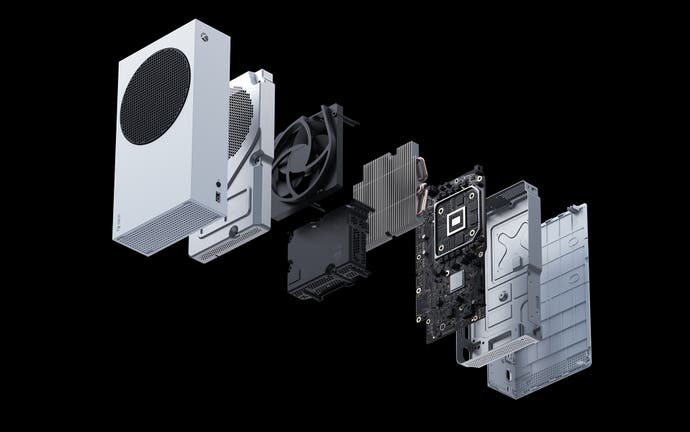
In Microsoft's recent HotChips presentation on the Xbox Series X, Microsoft's engineers also outlined how challenging it is to deliver a generational leap is in a world where silicon costs are problematic and where year-on-year drops in memory cost are tailing off. The presentation suggested that the 7nm process was not as cost-effective as the 16nm used for Xbox One X and S, but Andrew Goossen puts this into perspective:
"Well, it's still declined to 7nm - but you're right that the wins had been less and so it's definitely an ongoing industry trend with the cost per transistor relative to previous processes. The wins haven't been as big... going up to 7nm, but there have still been wins, 7nm is still cheaper per transistor than the previous ones. It's just after 7nm is where it potentially starts going up... you get those other benefits like the increased clock rates and you get the benefits of better power, but those aren't things that we can directly apply to cost reductions."
It's not all negative, though. The cost of NAND flash modules used for solid-state storage is still decreasing at a healthy rate - 23 per cent year-on-year according to the HotChips presentation - but the extent to which that will result in a cheaper console remains to be seen.
"Even with the flash, you know, that's a tough one because consumer expectation will be that they're getting more storage. So it's not really a cost reduction, right? Traditionally, we've always modelled a fixed cost for the HDD and you just increase capacity for that fixed cost," explains Goossen.
The end result will be that for a while at least, supporting both current-gen and next-gen Xbox hardware means that developers will be faced with the task of supporting four different SKUs. Xbox One X has already been discontinued, when an alternative course of action may have been to keep that as the entry level console as opposed to introducing Series S.
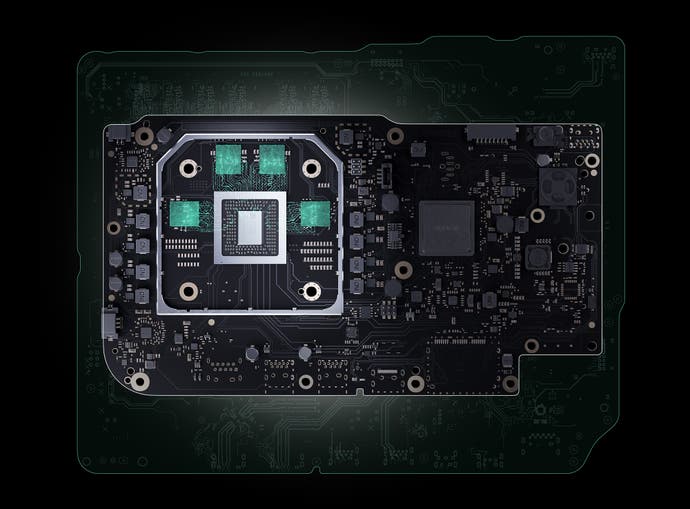
"I've read a lot of question on the internet, like, why isn't Microsoft going to continue Xbox One X as the low-end machine. Well, one thing is that it would last a long time through the generation and we felt that the new generation is defined by aspects such as the Xbox Velocity Architecture, and graphics features such as variable rate shading and ray tracing and the 4x processing performance boost on the CPU," counters Goossen. "And so we wanted to make sure that there was an entry level at the right price-point so that we could really advance the generation rather than hold it back. I've heard that Series S is going to hold back the next generation but I actually see Series S advancing it because by doing Series S we'll have more games written to the characteristics of the next generation."
There's also the matter of economics too. Our understanding is that a shrink of the Xbox One X's Scorpio Engine processor wouldn't be easy, while the wide memory interface isn't easily rationalised for an entry-level product. Its 12GB of GDDR5 (with 12 DRAM modules on the mainboard) would also be very hard to reduce down.
"The other ironic thing is that we did look at Xbox One X and we couldn't get it down to the price-point we wanted to get, so I look at Xbox Series S and it's cheaper than Xbox One X, it would have all of these next-gen features and then in terms of graphics performance, well you guys know this, but the per-cycle improvements with the new RDNA 2 architecture are like a 25 per cent improvement. If we just do the back of the envelope math right now, 4TF brings you up to 5TF just according to that factor.
"And some of the data we're seeing with our content is suggesting that it's even better, and then when you think about other features of the new architecture that we've added like variable rate shading and FP16, you know, I think that could get us the additional 20 per cent to pretty much equal the performance for new games... and it's cheaper and you get all the other features that define the new generation. And so for me, it was an easy decision - let's go do this."
Of course, since the interviews took place, we've actually experienced the Series consoles and a lot of the arguments about retaining Xbox One X as an entry-level machine rapidly evaporate simply due to quality of life improvements. Having the combination of the Zen 2 processors and the SSD makes even simple tasks like navigating the front-end a vastly improved experience - loading times are a night and day improvement and when a launch title like Watch Dogs Legions runs with hardware accelerated ray tracing, that's a feature Xbox One X couldn't deliver. Series S also includes one of the X's most impressive new features, Quick Resume, something else that wouldn't be possible on One X: "The other interesting little observation is that the Series S Quick Resume will be faster [than Series X], because there's less VM there for us to write and read back," adds Goossen. "The SSD [performance] is exactly the same between Series S and Series X."
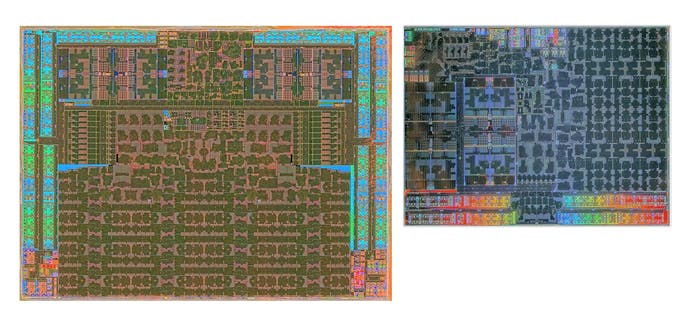
The advantages of Series S over One X also stack up in other dimensions too. While the older machine possessed excellent backward compatibility performance, it did have limits - you did not get the full GPU performance of the Scorpio Engine. The 40 CUs were split evenly between pixel and vertex shading, meaning an effective '3TF' of performance, for want of a better term. The CPU bump between One S and One X was also incremental, as opposed to delivering the generational improvement Series S offers up thanks to Zen 2.
"So, one thing we did is we designed the Series S to enhance the Xbox One S games in a way that the Xbox One X can't," explains Andrew Goossen. "We made it easy for existing Xbox One S games to be updated to run with double the frame-rate when played on Series S as well. When games are updated, existing games can query to determine whether they're running on the new console. And in terms of the performance, the Series S provides well over double the effective CPU and GPU performance over the Xbox One, making it pretty straightforward for the games to do this. And in fact, the Series S GPU runs the Xbox One S games with better performance than the Xbox One X.
"As you pointed out, on the One X, we had the asymmetry in terms of the fill and the vertex, we don't have that [here] and so ironically the S games run better on the Series S than they do on the Xbox One X. With so much headroom - you know, CPU and GPU - there's no real perf tuning necessary when you do this, and often it's just as easy as changing three lines of code and then the game just works. And even when it's not that easy, the fixes are still pretty minor. We had one triple-A title where doubling the frame-rate worked perfectly, except that the crowd animation was twice as fast as normal. And so those sorts of fixes are typically very, very easy for developers to go fix. And we're working with game developers and publishers to update - it'll basically be select games that run at a doubled frame-rate on the Series S."
Fallout 4 is the first announced game to deliver this doubling of frame-rate (it's still running at 30fps at the time of writing) and I'm really hoping that we see more - that we see a wide range of catalogue games revisited and enhanced. During my testing with backwards compatibility, the only way we could get any idea of the real world multiplier in CPU performance was in loading time tests, where the CPU decompresses data much faster than the last-gen Jaguars. In-game, back-compat eliminated every single CPU bottleneck we could find from last-gen titles. But the question is, who is responsible for delivering these upgrades - the developer, or Microsoft's compatibility team?





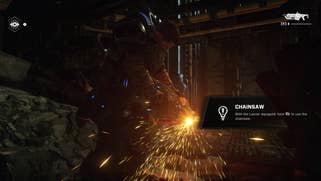


"In some cases, for more service-based games or games that are still have active communities, it'll actually be easier for the developer to do it," says Jason Ronald, partner director of program management at Xbox. "And then in other cases, we may be able to do things at our level, just kind of on behalf of the title, similar to how we've done it in the past. So these are all things that we're actively working through as we get closer to launch and we'll have more to share about specific enhancements in specific titles closer to launch."
A nice bonus - that we've previously revealed - is that all of the 4K enhanced Xbox 360 titles for the Xbox One X will retain some measure of their improvements for Xbox Series S. While the 'full fat' ultra HD experience is for Series X only, Series S users still get a 1440p upgrade - a 2x2 resolution multiplier on original native resolution. More generally, Xbox 360 and OG Xbox titles that still didn't hit frame-rate targets now stand a much better chance of doing so.
I've already reviewed the Xbox Series X console, and while I've nothing but admiration for the hardware, I found the review experience to be a little unfulfilling - mostly because the range of software available for the console was limited at that time, so getting the measure of the machine in its most crucial element was very difficult. Thankfully, many more titles are available now and I'll be handing in a Series S review soon - but as viewers of our video content will know, I've only got one real reservation about Series S beyond the limited storage space: the 8GB of available memory.
"The biggest consumers for memory are really the render targets and the texture budget and both of those shrink significantly with targeting the lower resolution - so 1440p is 44 per cent of the size of 2160p and so right there, all your render targets get less," says Andrew Goossen. "And with g-buffers and all that, that is a lot of memory right there in terms of memory consumption. And there, the texture budgets are very significant as well, so we feel good about the 8GB that we make available."
Microsoft has also pioneered technologies like shader feedback sampling, which see texture management handled much more efficiently - which can act as a multiplier on memory consumption, not to mention in reducing streaming bandwidth. With that said though, in a world where native 4K is far from a done deal even on Series X, I am still concerned about how memory management will play out on Series S.
There were some further topics I raised in the follow-up interview. First of all, both Series S and Series X GPUs feature support for INT-4 and INT-8 extensions on the shaders, opening the door to machine learning applications. The HotChips presentation mentioned AI upscaling as a use for this. "It's an area of very active research for us, but I don't really have anything more to say at this point," Goossen said.








And then there's the very interesting claim - succinctly expressed in this tweet - that the new Xbox consoles will be 'the only next-gen consoles with full RDNA 2 integration". In effect, Microsoft is suggesting that its GPU has features that PlayStation 5 does not. It's a claim that cannot be denied, mostly because such an unambiguous claim would have likely gone through stringent legal review (and would likely have been signed off with AMD too). Notably, of course, Sony has not denied it. What I can say is that back in April when AMD officially revealed RDNA 2, I did ask Sony whether the features in RDNA 2 not mentioned in Mark Cerny's presentation were present in PS5 or not, and no comment on the matter was forthcoming. But my question about Microsoft's specific claim was pretty straightforward and didn't quite get a straight answer. Put simply: if Xbox has the full RDNA 2 feature set, which of those features are only in the Xbox Series consoles?
Jason Ronald stepped up to tackle this one: "The real critical tentpoles when we think about RDNA 2 are DirectX ray tracing with hardware acceleration, mesh shader support, which we have full support for, and then obviously, variable rate shading. And beyond that, beyond the standard definition of RDNA2 that's where things like sampling, feedback streaming, and even things like DirectStorage come into play. And as you've seen... Nvidia recently announced support for DirectStorage as well.
"In some of these areas where we're innovating in the console space, our goal is actually drive this technology into the PC space as well because as we think about this future world of games running on consoles, on PCs on the cloud, we want to make it as easy for developers as possible. In these innovations that we put into the console, we're trying to drive those into the ecosystem, so that there's this common baseline that developers can count on regardless of where their game actually runs. So I think you're just seeing a lot of really good kind of cross pollination between the PC ecosystem and the console ecosystem. And then obviously, all of this moves to the cloud as well."
And I think that's actually the most important point of differentiation between Sony and Microsoft's visions for the next generation beyond specific spec points in what are otherwise similar graphics cores. The presence or otherwise of RDNA 2 features in PS5 will all come out in the wash in the inevitable Digital Foundry cross-platform game comparisons, of course, but what Jason Ronald is describing here is something much more fundamental - delivering next generation features that are not console exclusive, that will allow games to flourish on PC and the cloud too. That's part of a Microsoft strategy that is all about increasing the addressable size of the market: the firm loses money on every console made and can't produce financially viable hardware for many markets around the world. Getting the same games onto other hardware may not sit well with the ultra hardcore console gamer, but it's essential in taking Xbox truly global.
Xbox is already starting to move beyond being just a console-based ecosystem, and looking at the build cost issues that have made Series S the console it is today - and the projected outlook for semi-conductor costs going forward - I have to wonder for how much longer the concept of the generational leap will be viable for a cost-effective games machine? Looking ahead to the more immediate future though, I do think Series S is an intriguing product - and perhaps the right console for an economically uncertain age - and I'm really looking forward to seeing if resolution is indeed the only differentiating factor, or whether the big reductions in specification will have a more profound impact on next generation game development.
